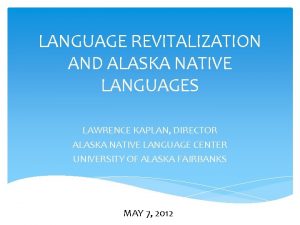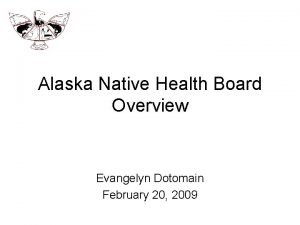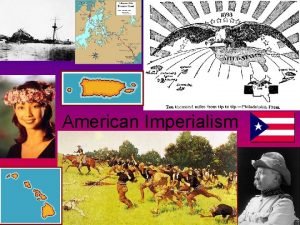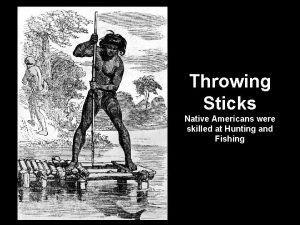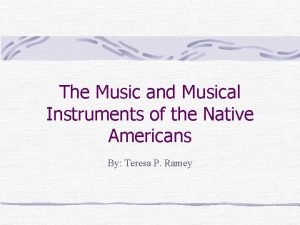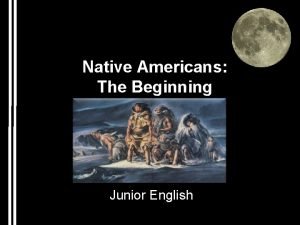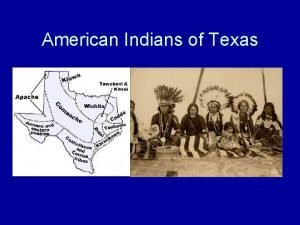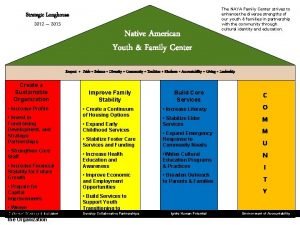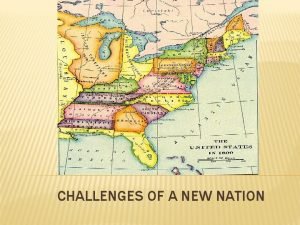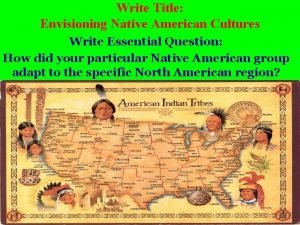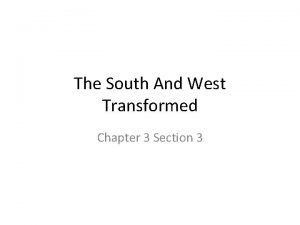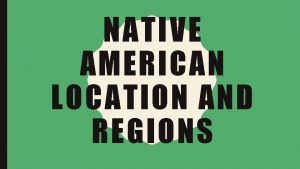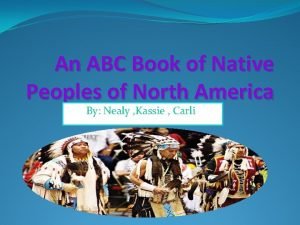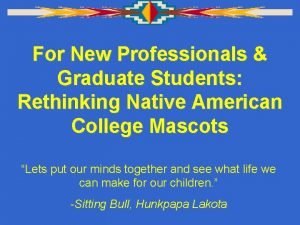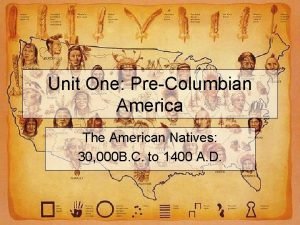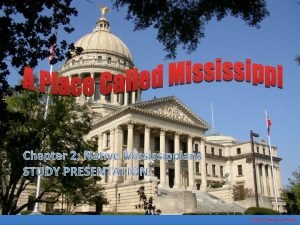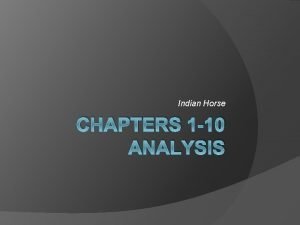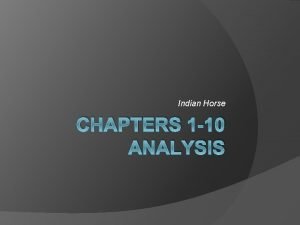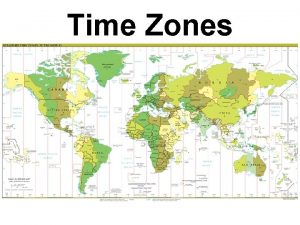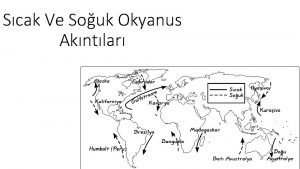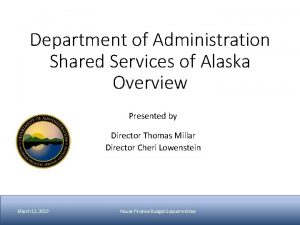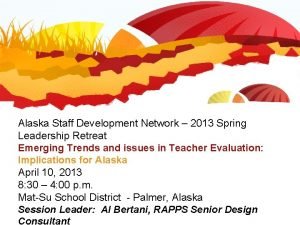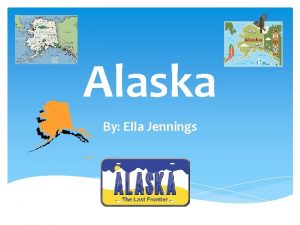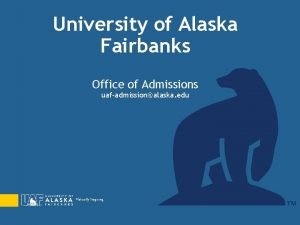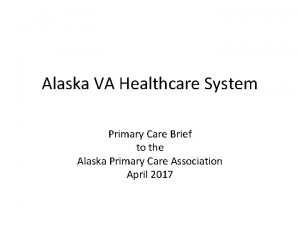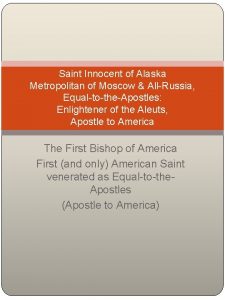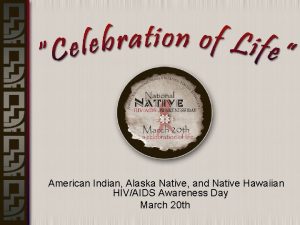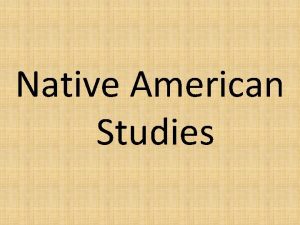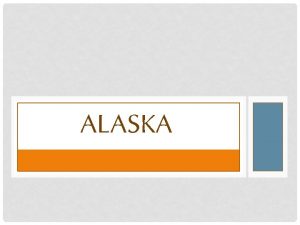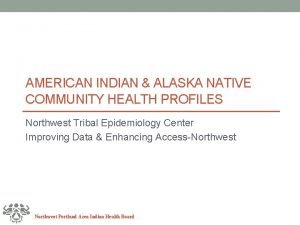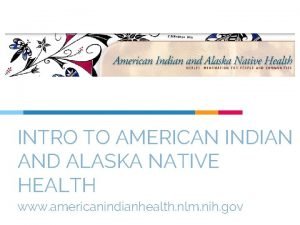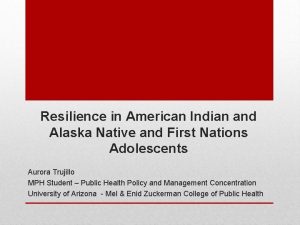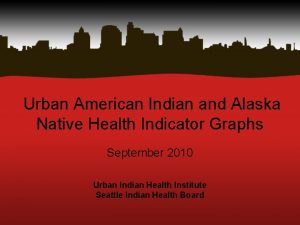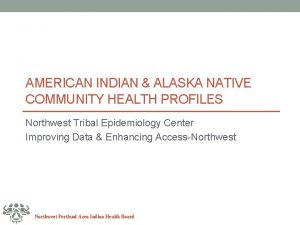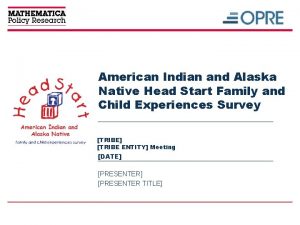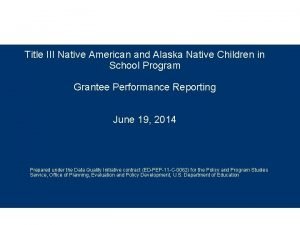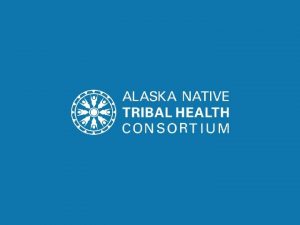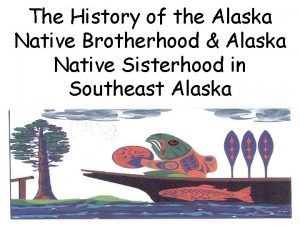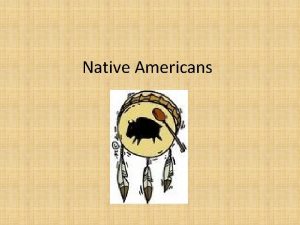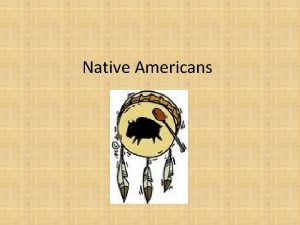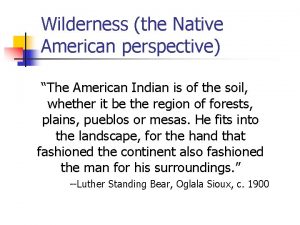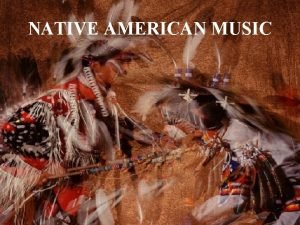Chapter 8 American Indian or Alaska Native Native






































































- Slides: 70

Chapter 8: American Indian or Alaska Native & Native Hawaiian or Other Pacific Islander May 2020

Introduction Title VI of the Every Student Succeeds Act (ESSA) is designed to ensure the unique cultural, linguistic, and educational needs of American Indian, Alaska Native, and Native Hawaiian students are met so that they can meet challenging State academic standards and gain an understanding of Native communities, tribal histories, and traditions. Aligning with federal reporting requirements, racial and ethnic identification is based on the responses to a two-part question. The first part determines whether a student is of Hispanic/Latino origin, while the second part determines which of the following groups define a student’s race: American Indian or Alaska Native, Asian, black or African American, white, or Native Hawaiian or other Pacific Islander. Students who identify as Hispanic or Latino are counted in the Hispanic category regardless of the race(s) indicated. The remaining students are categorized based on the race(s) indicated, with students who select more than one race counted in the two or more races category. Because of this methodology, the majority of students who indicate they are American Indian or Alaska Native, or Native Hawaiian or other Pacific Islander are coded as either Hispanic or two or more races. Although federal reporting refers only to those students solely identified as American Indian or Alaska Native, or Native Hawaiian or other Pacific Islander, Colorado also analyses the performance of all students (regardless of federal reporting identification) who identify with those racial categories. For comparison purposes, the tables and figures also include data on all Colorado students.

Characteristics

Student October • Information in this section reflects student demographics at the time of the Student October Snapshot only. The Colorado Department of Education (CDE) annually collects student demographic data from districts. When districts submit the data to CDE in October of each year, it is referred to as the Student October Snapshot. The “purpose of the Student October Snapshot is to determine funding for districts and schools by taking a count of students in attendance on the Pupil Enrollment Date” (Student October Data Elements and Definitions [http: //www. cde. state. co. us/datapipeline/studentoctoberdata]). Additional information is available on the CDE Pupil Membership webpage (www. cde. state. co. us/cdereval/pupilcurrent). To protect student privacy, Colorado suppresses any cells that do not meet minimum number requirements. "N/A" indicates a cell contains fewer than 16 students, or that complementary suppression rules were applied.

K-12 Enrollment During the 2018 -19 school year, 58, 476 total students in Kindergarten through 12 th grade indicated they were American Indian or Alaska Native, but only 6, 281 (10. 7%) of those students were classified in that racial/ethnic group based on federal reporting methodology. The majority (75. 2%; N = 43, 986) were federally identified as Hispanic or Latino because they indicated they were of Hispanic/Latino origin. Approximately 14. 0% (N = 8, 209) were federally identified as Two or More Races because they indicated more than one racial category. Based on federal identification, American Indian or Alaska Native students represent 0. 7% of the total student population, although 6. 7% of all students in the state indicated they were American Indian or Alaska Native. There were 9, 008 total students in K-12 who indicated they were Native Hawaiian or other Pacific Islander, and 2, 363 (26. 2%) were classified in that racial/ethnic group using the federal reporting methodology. The majority of students were federally identified as Two or More Races (38. 8%; N = 3, 497) or Hispanic or Latino (34. 9%; N = 3, 148). Based on federal identification, Native Hawaiian or other Pacific Islander students represent 0. 3% of the total student population, although 1. 0% of all students in the state indicated they were Native Hawaiian or other Pacific Islander.

Gender Statewide, the gender distribution of all K-12 students was 51. 3% male students and 48. 7% female students. The distribution for American Indian or Alaska Native students was 51. 0% male students. The distribution for Native Hawaiian or other Pacific Islander students was 51. 0% male students.

English Learners Approximately 14. 3% of students in the total K-12 population were identified as English learners. Of American Indian or Alaska Native students, 8. 5% were English learners. Of Native Hawaiian or other Pacific Islander students, 19. 5% were English learners.

English Language Proficiency Of the 6, 281 American Indian or Alaska Native students that were also identified as English learners in K-12, 23. 6% were non-English proficient, 61. 6% were limited English proficient, and 14. 7% were fluent English proficient in monitor years 1 or 2. Of the 2, 363 Native Hawaiian or other Pacific Islander students that were also identified as English learners in K 12, 36. 4% were non-English proficient, 51. 0% were limited English proficient, and 12. 6% were fluent English proficient in monitor years 1 or 2.

Free/Reduced Meals Eligibility Across Colorado, 40. 8% of all Colorado students were eligible for free/reduced meals (FRM), 61. 0% of American Indian or Alaska Native students were eligible for FRM, and 54. 7% of Native Hawaiian or other Pacific Islander students were eligible for FRM.

Students with Disabilities Approximately 10. 7% of all K-12 students were identified as students with disabilities (those with an Individualized Education Plan or IEP). In comparison, 15. 5% of American Indian or Alaska Native students and 7. 8% of Native Hawaiian or other Pacific Islander students were students with disabilities.

Disability Category Statewide, of the K-12 students identified with a disability, 42. 6% were identified as having a Specific Learning Disability, followed by 15. 4% of students identified as having a Speech / Language Disability. In comparison, 48. 4% of American Indian or Alaska Native students with a disability were identified as having a Specific Learning Disability, followed by 13. 6% identified as having a Speech / Language Disability. In addition, 40. 2% of Native Hawaiian or other Pacific Islander students with a disability were identified as having a Specific Learning Disability, followed by 13. 6% identified as having a Speech / Language Disability Category All Students Intellectual Disability Serious Emotional Disability Specific Learning Disability Hearing Impairment, Incl. Deafness Visual Impairment, Incl. Blindness Speech / Language Disability Deaf-Blindness Multiple Disabilities Autism Spectrum Disorders Traumatic Brain Injury Developmental Delay Infant/Toddler with a Disability Orthopedic Impairment Other Health Impairment 2. 6% 5. 5% 42. 6% 1. 3% 0. 3% 15. 4% 0. 0% 4. 3% 8. 1% 0. 5% 7. 0% 0. 4% 11. 9% Students Coded as All Students Native Hawaiian or American Indian or Identified as Native Other Pacific Alaska Native American Indian or Hawaiian or Other Islander (Federal Reporting) Alaska Native Pacific Islander Reporting) * 6. 0% 48. 4% * * 13. 6% * * 4. 9% * 7. 4% * * 11. 0% * * 40. 2% * * 13. 6% * * 12. 0% * 8. 7% * * 10. 9% 3. 6% 4. 5% 53. 9% 1. 4% * 12. 6% * 4. 2% 4. 8% 0. 5% 5. 2% * 0. 3% 8. 7% 3. 5% 5. 8% 39. 4% * * 15. 9% * 4. 3% 9. 2% * 9. 1% * * 9. 8%

Title I Services Approximately 36. 1% of all American Indian or Alaska Native students and 35. 4% of all Native Hawaiian or other Pacific Islander students were identified as receiving Title I services, compared to 25. 6% of all K-12 students in the state.

Migrant Students Statewide, less than one percent (0. 3%) of K-12 students were identified as migrant students. Fewer than 16 American Indian or Alaska Native students were identified as migrant students and fewer than 16 Native Hawaiian or other Pacific Islander students were identified as migrant students.

Students Experiencing Homelessness Across the state, 1. 5% of all K-12 students were experiencing homelessness based on the Student October Snapshot. Similarly, 3. 5% of American Indian or Alaska Native students and 3. 5% of American Indian or Alaska Native students were experiencing homelessness.

Students Identified as Gifted/Talented Approximately 7. 6% of all K-12 students, and 3. 0% of American Indian or Alaska Native students and 4. 0% of Native Hawaiian or other Pacific Islander students were identified as gifted or talented.

Location and Context

Districts with Highest Number of American Indian or Alaska Native students are located throughout the state, with 141 districts having at least one American Indian or Alaska Native student enrolled during the Student October Snapshot in the 2018 -19 school year. Zero districts had more than 1, 000 K-12 American Indian or Alaska Native students enrolled at the time of the Snapshot, with the top 10 districts each having enrolled more than 100 American Indian or Alaska Native students. Montezuma-Cortez Re -1 had the highest number of American Indian or Alaska Native students enrolled (N = 746), followed by Denver County 1 (N = 570) and Jefferson County R-1 (N = 548). Number (N) Students Percent (%) Students Coded as American Indian or Alaska Native (Federal Reporting) District Number District Name Number (N) All Students 2035 MONTEZUMA-CORTEZ RE-1 2, 686 746 27. 8% 0880 DENVER COUNTY 1 86, 928 570 0. 7% 1420 0130 0900 JEFFERSON COUNTY R-1 CHERRY CREEK 5 DOUGLAS COUNTY RE 1 81, 714 54, 275 65, 671 548 310 300 0. 7% 0. 6% 0. 5% 0180 ADAMS-ARAPAHOE 28 J 38, 010 252 0. 7% 1520 1540 DURANGO 9 -R IGNACIO 11 JT 5, 228 730 238 227 4. 6% 31. 1% 0020 ADAMS 12 FIVE STAR SCHOOLS 38, 095 214 0. 6% 1110 DISTRICT 49 22, 079 190 0. 9%

Districts with Highest Number of Native Hawaiian or other Pacific Islander students are located throughout the state, with 89 districts having at least one Native Hawaiian or other Pacific Islander student enrolled during the Student October Snapshot in the 2018 -19 school year. Zero districts had more than 1, 000 K-12 Native Hawaiian or other Pacific Islander students enrolled at the time of the Snapshot, with the top 10 districts each having enrolled more than 70 Native Hawaiian or other Pacific Islander students. Denver County 1 had the highest number of Native Hawaiian or other Pacific Islander students enrolled (N = 330), followed by Adams-Arapahoe 28 J (N = 303) and Cherry Creek 5 (N = 182). Number (N) Students Percent (%) Students Coded as Native Hawaiian or Other Pacific Islander (Federal Reporting) District Number District Name Number (N) All Students 0880 DENVER COUNTY 1 86, 928 330 0. 4% 0180 ADAMS-ARAPAHOE 28 J 38, 010 303 0. 8% 0130 CHERRY CREEK 5 54, 275 182 0. 3% 1000 FOUNTAIN 8 7, 861 156 2. 0% 1420 JEFFERSON COUNTY R-1 81, 714 136 0. 2% 1010 COLORADO SPRINGS 11 25, 624 133 0. 5% 0990 WIDEFIELD 3 9, 150 129 1. 4% 0980 HARRISON 2 11, 735 101 0. 9% 1110 DISTRICT 49 22, 079 93 0. 4% 1040 ACADEMY 20 25, 807 72 0. 3%

Districts with Highest Percentage of American Indian or Alaska Native students For two districts, American Indian or Alaska Native students represented at least one-quarter of their K-12 student population. The top 10 districts had student populations composed of at least 3. 3 percent American Indian or Alaska Native students. Ignacio 11 Jt had the highest percent of American Indian or Alaska Native students (31. 1%). Three districts were in the top 10 for both number and percent of American Indian or Alaska Native students: Durango 9 -R, Ignacio 11 Jt, Montezuma-Cortez Re-1. To protect student privacy, three districts with fewer than 16 American Indian or Alaska Native students were excluded. Number (N) Students Percent (%) Students Coded as American Indian or Alaska Native (Federal Reporting) District Number District Name Number (N) All Students 1540 IGNACIO 11 JT 730 227 31. 1% 2035 MONTEZUMA-CORTEZ RE-1 2, 686 746 27. 8% 0220 ARCHULETA COUNTY 50 JT 1, 706 125 7. 3% 2070 MANCOS RE-6 451 26 5. 8% 2055 1520 1390 DOLORES RE-4 A DURANGO 9 -R HUERFANO RE-1 655 5, 228 489 35 238 16 5. 3% 4. 6% 3. 3%

Districts with Highest Percentage of Native Hawaiian or other Pacific Islander students The top 10 districts had student populations composed of at least 0. 8 percent Native Hawaiian or other Pacific Islander students. Fountain 8 had the highest percent of Native Hawaiian or other Pacific Islander students (2. 0%). Four districts were in the top 10 for both number and percent of Native Hawaiian or other Pacific Islander students: Durango 9 -R, Ignacio 11 Jt, Montezuma-Cortez Re-1. To protect student privacy, six districts with fewer than 16 Native Hawaiian or other Pacific Islander students were excluded. Number (N) Students Percent (%) Students Coded as Native Hawaiian or Other Pacific Islander (Federal Reporting) District Number District Name Number (N) All Students 1000 FOUNTAIN 8 7, 861 156 2. 0% 0990 WIDEFIELD 3 9, 150 129 1. 4% 0980 HARRISON 2 11, 735 101 0. 9% 0180 ADAMS-ARAPAHOE 28 J 38, 010 303 0. 8%

Enrolled in Charter Schools Statewide, approximately 14. 0% of all K-12 students, 10. 9% of American Indian or Alaska Native students, and 14. 1% of Native Hawaiian or other Pacific Islander students were enrolled in a Charter school.

Enrolled in Online Schools Only 2. 2% of all K -12 students, 3. 4% of American Indian or Alaska Native students, and 2. 8% of Native Hawaiian or other Pacific Islander students were enrolled in online schools.

Enrolled in Schools with Innovation Status Statewide, 5. 1% of all K-12 students were enrolled in schools with Innovation status, whereas 4. 9% of American Indian or Alaska Native students and 9. 7% of Native Hawaiian or other Pacific Islander students were enrolled in schools with Innovation status.

Enrolled in Alternative Education Campuses (AECs) Approximately 2. 4% of all K-12 students, 4. 7% of American Indian or Alaska Native students, and 3. 2% of Native Hawaiian or other Pacific Islander students were enrolled in Alternative Education Campuses (AECs).

Colorado Regions Colorado is divided into eight regions in which districts are located: Metro, North Central, Northeast, Northwest, Pikes Peak, Southeast, Southwest, and West Central. Charter School Institute and Colorado Digital BOCES serve students throughout the state, and therefore are not assigned to a particular region.

Enrollment Across Regions Category Metro North Central Percent (%) of All Students Percent (%) of Students Coded as American Indian or Alaska Native (Federal Reporting) Percent (%) of Students Coded as Native Hawaiian or Other Pacific Islander (Federal Reporting) Percent (%) of All Students Identified as American Indian or Alaska Native Percent (%) of All Students Identified as Native Hawaiian or Other Pacific Islander 52. 3% 14. 4% 1. 6% 4. 0% 17. 4% 1. 4% 2. 4% 4. 1% Charter School Institute 2. 0% 41. 5% 8. 4% 1. 7% 2. 4% 15. 4% 1. 4% 24. 1% 3. 4% 1. 3% * * 52. 0% 7. 4% 1. 1% 1. 5% 31. 7% * 1. 1% 2. 0% 2. 1% * * 58. 8% 8. 1% 0. 8% 9. 2% 10. 6% 1. 4% 4. 6% 4. 4% 1. 7% * * 50. 7% 7. 7% 1. 1% 4. 0% 28. 9% 0. 5% 1. 4% 3. 4% 1. 9% * * Northeast Northwest Pikes Peak Southeast Southwest West Central The majority of K-12 students (52. 3%) were enrolled in the Metro region, followed by Pikes Peak (17. 4%) and North Central (14. 4%) regions. The majority of American Indian or Alaska Native students were enrolled in the Metro region (41. 5%), followed by Southwest (24. 1%) and Pikes Peak (15. 4%) regions. The majority of Native Hawaiian or other Pacific Islander students were enrolled in the Metro region (52. 0%), followed by Pikes Peak (31. 7%) and North Central (7. 4%) regions. Colorado Reenvisioned BOCES 0. 3% Colorado Detention Centers 0. 0%

Enrollment Within Regions The Southwest region had the highest proportion of American Indian or Alaska Native students (7. 3%), whereas the North Central region had the lowest proportion of American Indian or Alaska Native students (0. 4%). The Pikes Peak region had the highest proportion of Native Hawaiian or other Pacific Islander students (0. 5%), whereas the North Central region had the lowest proportion of Native Hawaiian or other Pacific Islander students (0. 1%). Region Metro North Central Northeast Northwest Pikes Peak Southeast Southwest West Central Number (N) Percent (%) Students Coded as Native Hawaiian or Number (N) All American Indian or Students Other Pacific Alaska Native Islander (Federal Reporting) 459, 455 2, 604 0. 6% 1, 229 0. 3% 126, 627 527 0. 4% 174 0. 1% 14, 288 107 0. 7% 27 0. 2% 35, 332 148 0. 4% 35 0. 1% 152, 509 969 0. 6% 750 0. 5% 11, 932 90 0. 8% * * 20, 642 1, 514 7. 3% 27 0. 1% 36, 274 211 0. 6% 47 0. 1% Charter School Institute 17, 986 84 0. 5% 49 0. 3% Colorado Reenvisioned BOCES 2, 475 * * Colorado Detention Centers 288 * *

Colorado Settings Districts are classified into one of six settings: Denver Metro, Urban-Suburban (population center over 30, 000 residents, but outside the Denver Metro area), Outlying City (population center of 7, 000 to 30, 000), Outlying Town (population center of 1, 000 to 7, 000), Remote (population center of less than 1, 000), or BOCES (Data Pipeline Frequently Requested Codes [www. cde. state. co. us/datapipeline/org_orgcodes]).

Enrollment Across Settings Category Percent (%) of All Students Percent (%) of Students Coded as American Indian or Alaska Native (Federal Reporting) Percent (%) of Students Coded as Native Hawaiian or Other Pacific Islander (Federal Reporting) Percent (%) of All Students Identified as American Indian or Alaska Native Percent (%) of All Students Identified as Native Hawaiian or Other Pacific Islander 55. 4% 4. 4% 8. 1% 3. 5% 28. 2% 0. 4% Colorado Detention Centers 0. 0% 42. 8% 18. 5% 7. 7% 7. 9% 22. 7% * * 53. 6% 2. 1% 3. 0% * 39. 0% * * 59. 4% 7. 8% 11. 4% 3. 3% 17. 7% * * 52. 7% 3. 8% 4. 2% 2. 0% 36. 9% * * Denver Metro Outlying City Outlying Town Remote Urban. Suburban Colorado BOCES The majority of K-12 students (55. 4%) were enrolled in Denver Metro settings, followed by Urban-Suburban settings (28. 2%). The majority of American Indian or Alaska Native students were enrolled in Denver Metro settings (42. 8%), followed by Urban-Suburban settings (22. 7%). The majority of Native Hawaiian or other Pacific Islander students were enrolled in Denver Metro settings (53. 6%), followed by Urban-Suburban settings (39. 0%).

Enrollment Within Regions The Outlying City setting had the highest proportion of American Indian or Alaska Native students (3. 0%), whereas the Denver Metro setting had the lowest proportion of American Indian or Alaska Native students (0. 6%). The Urban-Suburban setting had the highest proportion of Native Hawaiian or other Pacific Islander students (0. 4%), whereas the Outlying City setting had the lowest proportion of Native Hawaiian or other Pacific Islander students (0. 1%). Number (N) Students Percent (%) Students Coded as Native Coded as American Hawaiian or Other Indian or Alaska Native Pacific Islander (Federal Reporting) Setting Number (N) All Students Denver Metro Outlying City Outlying Town Remote Urban-Suburban 485, 960 38, 921 70, 973 30, 655 247, 841 2, 686 1, 162 482 496 1, 424 0. 6% 3. 0% 0. 7% 1. 6% 0. 6% 1, 266 50 70 * 922 0. 3% 0. 1% * 0. 4% Colorado BOCES 3, 170 * * Colorado Detention Centers 288 * *

Enrolled in Rural Districts Statewide, 10. 5% of all K -12 students were enrolled in rural districts and 4. 0% were enrolled in small rural districts. In comparison, 24. 9% of American Indian or Alaska Native students were enrolled in rural and 8. 4% in small rural districts, and 4. 7% of Native Hawaiian or other Pacific Islander students were enrolled in rural and 2. 0% in small rural districts.

Academic Achievement

Academic Achievement • Students in grades 3 through 8 were administered the Colorado Measures of Academic Success (CMAS) assessments in mathematics and English language arts, and students in grade 11 were administered the SAT assessment in mathematics and evidence-based reading and writing. In addition, students in grades 5, 8, and 11 were administered the CMAS assessment in science. Students with significant cognitive disabilities were eligible to take the Colorado Alternate (Co. Alt) assessments instead. For more information on the state assessments, and for school- and district-level results, please visit the CDE Assessment Unit webpage (www. cde. state. co. us/assessment). To protect student privacy, Colorado suppresses any cells that do not meet minimum number requirements. Data omitted from the following graphs indicates fewer than 16 students, or that complementary suppression rules were applied.

Performance on CMAS Math Assessment (Grades 3 -8) Statewide, the majority of students scored in level 4 (Met Expectations, 29. 3%) and level 3 (Approached Expectations, 27. 3%). The majority of American Indian or Alaska Native students scored in level 2 (Partially Met Expectations, 32. 2%) and level 1 (Did Not Yet Meet Expectations, 25. 1%). The majority of Native Hawaiian or other Pacific Islander students scored in level 3 (Approached Expectations, 26. 7%) and level 2 (Partially Met Expectations, 25. 9%).

Students Meeting/Exceeding Expectations on CMAS Math Assessment (Grades 3 -8) Statewide, approximately 34. 7% of students in grades 3 through 8 met or exceeded state expectations, compared to 18. 3% of American Indian or Alaska Native students and 25. 9% of Native Hawaiian or other Pacific Islander students.

Performance on SAT Math Assessment (Grade 11) Statewide, 39. 0% of students were at or above benchmark on the SAT math assessment, compared to 19. 0% of American Indian or Alaska Native students and 31. 3% of Native Hawaiian or other Pacific Islander students.

Performance on CMAS ELA Assessment (Grades 3 -8) Statewide, the majority of students scored in level 4 (Met Expectations, 36. 8%) and level 3 (Approached Expectations, 24. 7%). The majority of American Indian or Alaska Native students scored in level 3 (Approached Expectations, 26. 9%) and level 4 (Met Expectations, 25. 7%). The majority of Native Hawaiian or other Pacific Islander students scored in level 4 (Met Expectations, 29. 8%) and level 3 (Approached Expectations, 27. 2%).

Students Meeting/Exceeding Expectations on CMAS ELA Assessment (Grades 3 -8) Statewide, approximately 45. 8% of students in grades 3 through 8 met or exceeded state expectations, compared to 29. 2% of American Indian or Alaska Native students and 35. 9% of Native Hawaiian or other Pacific Islander students.

Performance on SAT ELA Assessment (Grade 11) Statewide, 58. 5% of students were at or above benchmark on the SAT math assessment, compared to 38. 2% of American Indian or Alaska Native students and 46. 3% of Native Hawaiian or other Pacific Islander students.

Performance on CMAS science Assessment (Grades 5, 8, and 11) Statewide, the majority of students scored in level 2 (Approached Expectations, 35. 5%) and level 1 (Partially Met Expectations, 33. 8%). The majority of American Indian or Alaska Native students scored in level 1 (Partially Met Expectations, 49. 2%) and level 2 (Approached Expectations, 35. 4%). The majority of Native Hawaiian or other Pacific Islander students scored in level 1 (Partially Met Expectations, 46. 4%) and level 2 (Approached Expectations, 35. 1%).

Students Meeting/Exceeding Expectations on CMAS science Assessment (Grades 5, 8, and 11) Statewide, approximately 30. 7% of students met or exceeded state expectations, compared to 15. 4% of American Indian or Alaska Native students and 18. 6% of Native Hawaiian or other Pacific Islander students.

Academic Growth

Academic Growth • Colorado calculates student growth for the CMAS and SAT math and English language arts assessments. A student growth percentile (SGP) defines how much relative growth a student made, compared to that student’s academic peers. The Colorado Growth Model essentially compares each student’s current achievement to students in the same grade throughout the state who had similar scores in past years. A student growth percentile of 60, for example, indicates a student grew as well as or better than 60% of his/her academic peers. The median is then calculated by taking the individual student growth percentiles of all the students in the group being analyzed, ranking them from lowest to highest, and identifying the middle score. Medians are more appropriate to use than averages when summarizing a collection of percentile scores. For more information regarding median growth percentiles (MGPs), please visit the Colorado Growth Model FAQs (www. cde. state. co. us/schoolview/generalgrowthmodelfaq#q 22).

Median Growth Percentiles on CMAS math assessment The median growth percentile (MGP) for all Colorado students (grades 4 through 8) on the CMAS math assessment was 50. 0, compared to an MGP of 48. 0 for American Indian or Alaska Native students and 45. 0 for Native Hawaiian or other Pacific Islander students.

Levels of growth on CMAS math assessment Statewide, on the CMAS math assessment, 34. 5% of all students demonstrated high growth, 31. 0% demonstrated typical growth, and 34. 5% demonstrated low growth. In comparison, 32. 6% of American Indian or Alaska Native students had high growth and 37. 0% had low growth, while 30. 1% of Native Hawaiian or other Pacific Islander students had high growth and 37. 6% had low growth.

Median Growth Percentiles on SAT math assessment The median growth percentile (MGP) for all Colorado students (grade 11) on the SAT math assessment was 51. 0, compared to an MGP of 43. 0 for American Indian or Alaska Native students and 56. 0 for Native Hawaiian or other Pacific Islander students.

Levels of growth on SAT math assessment Statewide, on the SAT math assessment, 35. 0% of all students demonstrated high growth, 30. 9% demonstrated typical growth, and 34. 1% demonstrated low growth. In comparison, 30. 4% of American Indian or Alaska Native students had high growth and 39. 4% had low growth, while 38. 3% of Native Hawaiian or other Pacific Islander students had high growth and 32. 7% had low growth.

Median Growth Percentiles on CMAS ELA assessment The median growth percentile (MGP) for all Colorado students (grades 4 through 8) on the CMAS ELA assessment was 50. 0, compared to an MGP of 48. 0 for American Indian or Alaska Native students and 47. 0 for Native Hawaiian or other Pacific Islander students.

Levels of growth on CMAS ELA assessment Statewide, on the CMAS ELA assessment, 34. 5% of all students demonstrated high growth, 31. 0% demonstrated typical growth, and 34. 5% demonstrated low growth. In comparison, 32. 3% of American Indian or Alaska Native students had high growth and 36. 5% had low growth, while 32. 5% of Native Hawaiian or other Pacific Islander students had high growth and 34. 1% had low growth.

Median Growth Percentiles on SAT ELA assessment The median growth percentile (MGP) for all Colorado students (grade 11) on the SAT ELA assessment was 49. 0, compared to an MGP of 48. 0 for American Indian or Alaska Native students and 50. 0 for Native Hawaiian or other Pacific Islander students.

Levels of growth on SAT ELA assessment Statewide, on the SAT ELA assessment, 34. 2% of all students demonstrated high growth, 30. 0% demonstrated typical growth, and 35. 8% demonstrated low growth. In comparison, 31. 1% of American Indian or Alaska Native students had high growth and 37. 9% had low growth, while 33. 6% of Native Hawaiian or other Pacific Islander students had high growth and 37. 4% had low growth.

Graduation Rates

Graduation Rates • ESSA requires states to present the four-year adjusted cohort graduation rates, but also gives states the discretion to include extended-year adjusted cohort graduation rates as well. Extended-year rates account for students who may require additional time to complete high school, such as those in five-year programs (e. g. , ASCENT: Accelerating Students through Concurrent Enrollment, a state program that allows a limited number of students to attend a post-secondary education after completion of 12 th grade, while still in the K-12 system), those who started below grade-level, and students whose coursework is interrupted for a semester or more. For more information on graduation rates, and for schooland district-level results, please visit the CDE Graduation Statistics webpage (www. cde. state. co. us/cdereval/gradratecurrent).

4 -Year Graduation Rate Student Group All Students Coded as American Indian or Alaska Native (Federal Reporting) Students Coded as Native Hawaiian or Other Pacific Islander (Federal Reporting) Number (N) of Students in Graduation Base Number (N) of Graduates Graduation Rate (%) 65, 933 53, 240 80. 7% 552 378 68. 5% 165 122 73. 9% The 4 -year adjusted cohort graduation rate for the class of 2018 shows that 80. 7% of all students in the 2017 -18 cohort graduated within four years, compared to 68. 5% for American Indian or Alaska Native students and 73. 9% for Native Hawaiian or other Pacific Islander students.

7 -Year Graduation Rate Student Group All Students Coded as American Indian or Alaska Native (Federal Reporting) Students Coded as Native Hawaiian or Other Pacific Islander (Federal Reporting) Number (N) of Students in Graduation Base Number (N) of Graduates Graduation Rate (%) 61, 111 52, 314 85. 6% 503 379 75. 3% 162 137 84. 6% The 7 -year adjusted cohort graduation rate for the class of 2015 shows that 85. 6% of all students in the 2014 -15 cohort graduated within seven years, compared to 75. 3% for American Indian or Alaska Native students and 84. 6% for Native Hawaiian or other Pacific Islander students.

School Quality or Student Success (SQSS)

School Quality or Student Success (SQSS) Indicator • Under ESSA, states are required to select at least one indicator of school quality or student success. For elementary and middle grade spans, Colorado is using mean scale scores on the 5 th and 8 th grade CMAS science assessment, as well as change in chronic absenteeism rates. For high school grade spans, Colorado is using mean scale scores on the 11 th grade CMAS science assessment, as well as dropout rates. Mean scale scores on the CMAS science assessment and dropout rates are presented. Colorado is continuing to evaluate the data quality of chronic absenteeism rates; therefore, change in chronic absenteeism is not currently reported.

Mean Scale Scores (MSS) on CMAS science Assessment The mean scale score (MSS) on the CMAS science assessment was 587. 9 for all students in grades 5, 8, and 11, compared to an MSS of 543. 6 for American Indian or Alaska Native students and 552. 2 for Native Hawaiian or other Pacific Islander students.

Dropout Rate Student Group Number (N) of Total Students Number (N) of Dropouts Dropout Rate (%) All Students Coded as American Indian or Alaska Native (Federal Reporting) Students Coded as Native Hawaiian or Other Pacific Islander (Federal Reporting) 309, 736 9, 769 3. 2% 2, 551 151 5. 9% 857 37 4. 3% Statewide, 3. 2% of all students discontinued their educational services without receiving credentials or providing adequate documentation of a transfer to another educational setting. In comparison, 5. 9% of American Indian or Alaska Native students and 4. 3% of Native Hawaiian or other Pacific Islander students were considered dropouts.

Long-Term Goals

Long-Term Goals Under ESSA • Under ESSA, states are required to establish long-term goals and measures of interim progress. Colorado uses mean scale scores (MSS) on the ELA and math assessments to measure progress towards long-term goals in academic achievement.

Mean Scale Scores (MSS) on CMAS math Assessment The mean scale score (MSS) for all students in grades 3 through 8 was 735. 6 on the CMAS math assessment. In comparison, the MSS for American Indian or Alaska Native students was 721. 0 and the MSS for Native Hawaiian or other Pacific Islander students was 727. 0.

Mean Scale Scores (MSS) on CMAS ELA Assessment The mean scale score (MSS) for all students in grades 3 through 8 was 744. 1 on the CMAS ELA assessment. In comparison, the MSS for American Indian or Alaska Native students was 730. 6 and the MSS for Native Hawaiian or other Pacific Islander students was 734. 9.

Mean Scale Scores (MSS) on SAT math Assessment The mean scale score (MSS) for all students in grade 11 was 494. 7 on the SAT math assessment. In comparison, the MSS for American Indian or Alaska Native students was 440. 5 and the MSS for Native Hawaiian or other Pacific Islander students was 469. 1.

Mean Scale Scores (MSS) on SAT ELA Assessment The mean scale score (MSS) for all students in grade 11 was 503. 9 on the SAT ELA assessment. In comparison, the MSS for American Indian or Alaska Native students was 455. 7 and the MSS for Native Hawaiian or other Pacific Islander students was 476. 7.

Participation Rates

Participation Rates • Students in grades 3 through 8 were administered the Colorado Measures of Academic Success (CMAS) assessments in mathematics and English language arts, and students in grade 11 were administered the SAT. In addition, students in grades 5, 8, and 11 were administered the CMAS assessment in science. Students with significant cognitive disabilities were eligible to take the Colorado Alternate (Co. Alt) assessments instead. For more information on the state assessments, and for school- and district-level results, please visit the CDE Assessment Unit webpage (www. cde. state. co. us/assessment).

Participation on the Math Assessments (Grades 38 and 11) Statewide, approximately 94. 1% of students in grades 3 through 8 and grade 11 were assessed, compared to 92. 8% of American Indian or Alaska Native students and 95. 2% of Native Hawaiian or other Pacific Islander students.

Participation on the ELA Assessments (Grades 3 -8 and 11) Statewide, approximately 94. 2% of students in grades 3 through 8 and grade 11 were assessed, compared to 93. 0% of American Indian or Alaska Native students and 94. 8% of Native Hawaiian or other Pacific Islander students.

Participation on the science Assessments (Grades 5, 8, and 11) Statewide, approximately 82. 3% of students in grades 5, 8, and 11 were assessed, compared to 83. 6% of American Indian or Alaska Native students and 82. 4% of Native Hawaiian or other Pacific Islander students.
 Thank you in alaska native languages
Thank you in alaska native languages Alaska native health board
Alaska native health board Russia wants alska
Russia wants alska Native american stick toss game
Native american stick toss game Native american musical instruments
Native american musical instruments How long have native american been living in america
How long have native american been living in america Native american religious beliefs
Native american religious beliefs Characteristics of native american literature
Characteristics of native american literature Indigenous medicine wheel colours
Indigenous medicine wheel colours Native american literature definition
Native american literature definition Native american dwellings
Native american dwellings Sun explosion candy
Sun explosion candy Native american youth and family center
Native american youth and family center Native connections housing
Native connections housing Native american important facts
Native american important facts Native american tribes
Native american tribes What three circumstances hurt native americans
What three circumstances hurt native americans Sioux writing
Sioux writing Indian skywalkers
Indian skywalkers Native american tribes in the united states
Native american tribes in the united states Chapter 14 test form a pre columbian america answers
Chapter 14 test form a pre columbian america answers Native american calendars
Native american calendars Native american abc book
Native american abc book Native american letting go ceremony
Native american letting go ceremony Native american morals and values
Native american morals and values Crayola crayons
Crayola crayons Native american burial grounds candy
Native american burial grounds candy Southern literature syllabus
Southern literature syllabus American gothic literature definition
American gothic literature definition What is the theme of pandora's box
What is the theme of pandora's box Native american writing
Native american writing Native american movie
Native american movie Native american healing prayers for the sick
Native american healing prayers for the sick Indian vs american culture
Indian vs american culture American indian cultural region
American indian cultural region Chapter 2 native mississippians
Chapter 2 native mississippians Maymaygwayseeuk
Maymaygwayseeuk Zhaunagush meaning
Zhaunagush meaning Chapter 15 india and the indian ocean basin notes
Chapter 15 india and the indian ocean basin notes Chapter 15 india and the indian ocean basin
Chapter 15 india and the indian ocean basin Alaska time zone
Alaska time zone Alaska easternmost state
Alaska easternmost state State of ak retirement
State of ak retirement Kanarya su akıntısı
Kanarya su akıntısı Texas compared to alaska
Texas compared to alaska Hb 172 alaska
Hb 172 alaska Rick domingo alaska airlines
Rick domingo alaska airlines Alos palsar dem download
Alos palsar dem download Shared services alaska
Shared services alaska Alaska staff development network
Alaska staff development network Alaska postsecondary education
Alaska postsecondary education Alaska commission on aging
Alaska commission on aging Alaska's state nickname
Alaska's state nickname Bahamas proper adjective
Bahamas proper adjective University of alaska fairbanks admissions
University of alaska fairbanks admissions United fishermen of alaska
United fishermen of alaska Anthc epicenter
Anthc epicenter Va hospitals in alaska
Va hospitals in alaska Alaska posizione geografica
Alaska posizione geografica Wasilla high school graduation 2022
Wasilla high school graduation 2022 Stevens village bison farm
Stevens village bison farm Evan ramsey alaska
Evan ramsey alaska Saint innocent of alaska
Saint innocent of alaska A westerly wind means that the atmosphere
A westerly wind means that the atmosphere Alaska purchased from canada
Alaska purchased from canada Alaska arizona arkansas
Alaska arizona arkansas Begich towers whittier alaska
Begich towers whittier alaska Uaa dental
Uaa dental Denali oncology group alaska
Denali oncology group alaska Alaska capital
Alaska capital Alaska performance scholarship
Alaska performance scholarship
